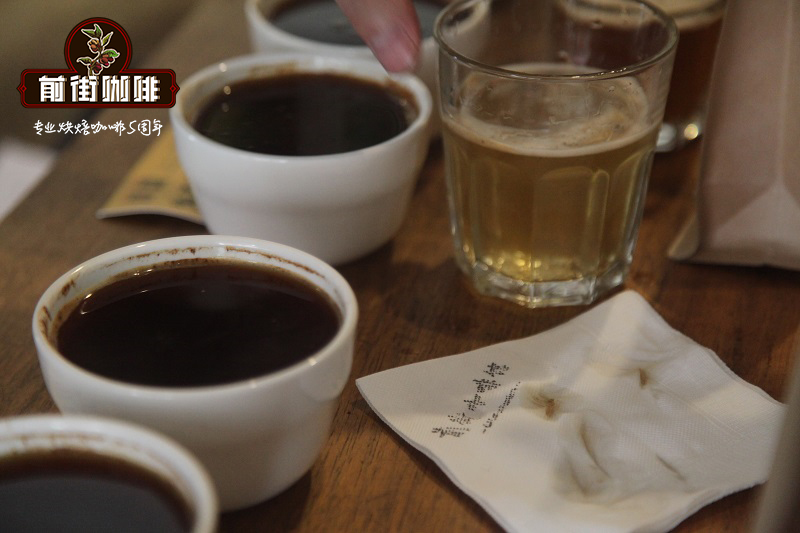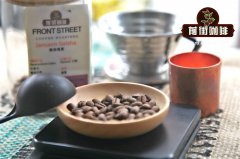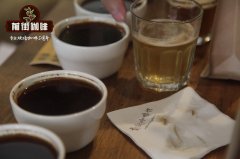What is the Brazilian cup test, what is the standard cup test, and the difference between Brazil and the standard cup test?

Professional coffee knowledge exchange more coffee bean information please follow the coffee workshop (Wechat official account cafe_style)
Brazilian cup test method:
1. Grind the roasted coffee moderately, put 10 grams into the cup and inject 150 milliliters of hot water. The roasting degree of coffee is about 65% of the value of "caramelization tester", which is about the degree of "cinnamon roasting" (light to moderate roasting in the United States). "Agtron" is the baking degree index mainly used in the United States, which is measured by a special colorimeter.
two。 Stir the coffee powder in hot water with a spoon to smell the fragrance. The next step is to remove the foam and scoop a spoonful of coffee liquid into the mouth with a test spoon. To confirm the defects of the coffee liquid, suck the liquid into the upper jaw and let the coffee liquid spread out in a fog in the mouth. It's not very elegant, but it confirms the smell. Coffee is graded according to this series of sensory reviews, based on "Soft", "Hard" and "iodine". "mild" refers to the soft and elegant sour taste and strong mellow, "difficult" refers to the astringent taste like persimmon, "iodine taste" is the taste of carbonic acid and so on.
This time, let's share the preparation homework for the SCAA standard.
1. Preparation tools are required for cup testing:
Samples of raw beans and their cooked beans
Agtron spectrum analyzer
Bean grinder
Glass / or porcelain bowl (cup test container, the instrument used in the same cup test should be of the same material, and the common ones are 5oz or 6oz Manhattan Glass or Rock Glass. For white porcelain cups, the recommended capacity is between 175and 225ml)
Cup meter, empty bowl (spitting coffee liquid), cup spoon, electric kettle, timer
two。 Basic requirements for cup testing environment:
Cup test table (necessary)
Clean, quiet, no other aroma interference
3. Roasting/ baking (preparation of cup test sample)
The cooked beans should be finished within 8-24 hours before the cup test, and the cooked beans should be kept for at least 8 hours.
Baking degree: according to the standard value of M-Basic (Gourmet) Agtron, the baking degree is from light baking to light baking, the bean value is 58, the powder value 63 is 55-60.
Baking time: more than 8 minutes-less than 12 minutes, no scorching and peeling
Cooked beans should be cooled by air immediately, not by water cooling.
When the sample bean temperature drops to room temperature (about 20 degrees), put it in a sealed container or airtight bag until you start the cup test to reduce contact with air and prevent contamination.
Sample beans should be kept in the shade temporarily, but do not need to be frozen or refrigerated.
4. Determining/ coffee quantity:
8.25g coffee: 150ml water. It conforms to the best brewing ratio of Golden Cup. However, the proportion of coffee powder can be adjusted according to the glass capacity used in the cup test, and the difference is about plus or minus 0.25 grams.
5. Water injection:
Grind the sample beans before the cup test, and complete the water injection within 15 minutes after grinding. Do not soak coffee powder for more than 30 minutes after injecting water.
According to the coffee proportion mentioned above, the proportion of water is adjusted according to the weight of coffee beans (not ground coffee powder).
Coffee beans are ground more finely than filter paper (for example, they are usually ground into ordinary granulated sugar particles, and that cup test is about fine granulated sugar particles), which means that 20Mesh-sized meshes in the United States can be used as a standard of about 70%. In order to make the test more accurate, prepare 5 cups of each sample bean tested in the cup
Each of the two methods has its own purpose and use, but today is the era of high-quality high-quality coffee. In the past, the negative evaluation of looking for defects has been meaningless, instead, the positive evaluation of coffee personality and aroma is the mainstream of the times.
The United States, the largest importer of Brazilian coffee, has changed its evaluation method from "negative cup test" to "positive cup test". Brazil, which originally used the most common commercial coffee as the main force of the international market, finally spread the evaluation method of "Cup of Excellence (COE)" to the world through Brazilian production enterprises after several failed experiments. Thus it can be seen that the "positive cup test" method has really become the mainstream.
The sensory examination of the Brazilian cup test is generally applicable to most consumer countries in the world. The baking degree used in the cup test is set to "cinnamon baking" because it does predict the taste change between shallow baking and deep baking. With the deeper the roasting degree of coffee, the more volatile ingredients, the taste will change, so choose the roasting degree before volatilization, that is, shallow roasting to measure the cup.
In fact, there is another reason. The largest importer of Brazilian coffee is the United States. The United States entered the 1980s with light roasting, the heyday of American coffee. It is only natural that Brazil, the producer, will match the American habit of using shallow baking during cup testing. If the baking method in the United States was deeper at that time, then the Brazilian cup would have been baked more deeply.
It is quite risky to change coffee suitable for light or cinnamon roasting to French or Italian roasting and put it on the menu. Because even if the taste is excellent after light roasting, it does not mean that the coffee is suitable for deep roasting. Therefore, the baking degree of cinnamon measured by Brazilian cup is not necessarily used in cup testing, and it is better to use deep roasting in coffee cups suitable for deep roasting.
The defective taste of raw beans can be clearly found after shallow baking. Unlike immature beans, which are as difficult to distinguish as ordinary beans once they are deeply baked, shallow baking can easily tell the difference from their appearance.
When using raw beans for the first time, first bake them in a shallow degree, then test them in a coffee cup, bake them to a predetermined baking degree if they taste good, and then test them again. Shallow baking cup test has considerable advantages, but just knowing the taste of defects does not mean that you know the taste of the whole. No matter what kind of coffee needs to be tested, it is best to bake it to the second burst period, because it will produce rich aroma and delicacy in the early stage of the second burst. Although the aroma evaluation of SCAA (American boutique Coffee Association) (click to learn about SCAA cup measurement) uses the baking degree of around Agtron50 (city roasting), the rich flavor of coffee will not appear until it enters the second burst period. I hope you can understand this.
.
END
For more professional coffee exchanges, please scan the code and follow Wechat: qiannjie

Please indicate the source of the reprint.
Important Notice :
前街咖啡 FrontStreet Coffee has moved to new addredd:
FrontStreet Coffee Address: 315,Donghua East Road,GuangZhou
Tel:020 38364473
- Prev

How about Rainforest Alliance Coffee beans? rainforest Alliance certified how to brew frog beans?
Professional coffee knowledge exchange more information about coffee beans Please follow the coffee workshop (Wechat official account cafe_style) there is an obvious frog on the rainforest certification logo, Rainforest Alliance certified coffee, also known as frog beans. Rainforest Alliance RA (Rainforest Alliance) certification refers to a farm that meets the standards set by the Rainforest Alliance, and the Alliance will treat the farm and its surroundings
- Next

Manual coffee kono filter cup tutorial kono filter cup manual brewing method and brewing steps
Professional coffee knowledge exchange more information about coffee beans Please pay attention to the height, flow rate and disturbance of the water column in the coffee workshop (Wechat official account cafe_style), which are the key factors affecting hand-brewed coffee. The most interesting thing about hand flushing is that it has never had a standard SOP, and any variable may affect the flavor of coffee. Will show readers the KONO genre bit by bit
Related
- Beginners will see the "Coffee pull flower" guide!
- What is the difference between ice blog purified milk and ordinary milk coffee?
- Why is the Philippines the largest producer of crops in Liberia?
- For coffee extraction, should the fine powder be retained?
- How does extracted espresso fill pressed powder? How much strength does it take to press the powder?
- How to make jasmine cold extract coffee? Is the jasmine + latte good?
- Will this little toy really make the coffee taste better? How does Lily Drip affect coffee extraction?
- Will the action of slapping the filter cup also affect coffee extraction?
- What's the difference between powder-to-water ratio and powder-to-liquid ratio?
- What is the Ethiopian local species? What does it have to do with Heirloom native species?

